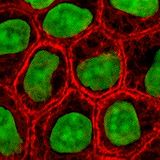User:Julie Zamostny/BIO134: Cancer Biology
Cancer Biology is a one-hundred level course taught by Dr. Thomas Turbyville at Hood College in Frederick, Maryland.

Course Objectives The course is designed to introduce the student to what cancer biology is, and how cancer biology helps us to identify and exploit therapeutic targets. In understanding “what cancer biology is,” we will define and investigate several important hallmarks of cancer cells: growth signal autonomy, evasion of growth inhibitory signals, evasion of apoptosis, unlimited replicative potential, invasion and metastasis, angiogenesis, evasion of host immune responses, and the stress phenotypes of cancer cells. In learning about “therapeutic targets,” we will investigate how the physiological capabilities acquired by cancer cells can also serve as targets for developing effective anticancer drugs. We will deepen our understanding of these topics by reading scientific review articles, and discussing them at length in class. Further, we will address the impact of cancer on the individual cancer patient by reading and discussing a book written by a cancer survivor. From learning about the major themes of cancer biology, and reading widely about the application of the scientific method to cancer, the student will be equipped to understand the centrality of biology to the modern world.
Background/Introduction
[edit]The 19th-century English physiologist Sydney Ringer developed salt solutions containing the chlorides of sodium, potassium, calcium and magnesium suitable for maintaining the beating of an isolated animal heart outside of the body.[1] In 1885 Wilhelm Roux removed a portion of the medullary plate of an embryonic chicken and maintained it in a warm saline solution for several days, establishing the principle of tissue culture.[1] Ross Granville Harrison, working at Johns Hopkins Medical School and then at Yale University, published results of his experiments from 1907-1910, establishing the methodology of tissue culture.[2]
- ^ ""Animals and alternatives in testing."". Retrieved 2006-04-19.
- ^ Schiff, Judith Ann. ""An unsung hero of medical research."". Retrieved 2006-04-19. Yale Alumni Magazine, February 2002.
